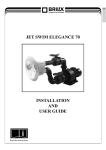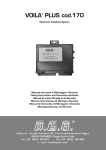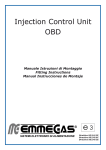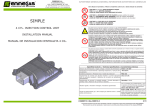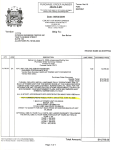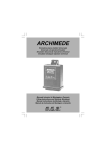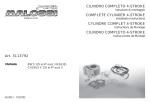Download FCS-233si (Galileo)
Transcript
FCS-233si (Galileo) Sistema Elettronico Feedback con Emulatore Stacca Iniettori incorporato Electronic Feedback System with incorporated Cut Injectors Emulator Cod. 105170 FCS-233si Manuale Istruzioni di Montaggio Fitting Instructions Index Italiano • • • • • • • Avvertenze generali Principio di funzionamento Configurazione originale Descrizione componenti Schemi di collegamento SENSORI DI LIVELLO Schemi di collegamento CABLAGGI STACCA INIETTORI Schema d’installazione 3 4 5 6 10 11 12 General information Principle of operation Original configuration Component description FUEL LEVEL SENSOR wiring diagrams CUT INJECTORS CABLES wiring diagrams Installation diagram 13 14 15 16 20 21 22 English • • • • • • • EMMEGAS S.p.A v. G. Falcone, 5 42021 Barco (RE) - Italy Tel. +39 0522 246500 Fax +39 0522 246502 http://www.emmegas.net E-mail: [email protected] Avvertenze generali Italiano Dove fissare il Sistema Feedback: - LONTANO da possibili INFILTRAZIONI D’ACQUA. - LONTANO da ECCESSIVE FONTI DI CALORE (esempio collettori di scarico). - LONTANO dai CAVI DELL’ALTA TENSIONE. Fare delle buone connessioni elettriche evitando l’uso dei “RUBACORRENTE”. Si tenga presente che la migliore connessione elettrica è la saldatura debitamente isolata. Avvisare il cliente che in caso di rottura del fusibile dell’impianto a GAS, il Sistema Feedback ripristina i collegamenti dei dispostivi a cui è collegato. Non aprire per nessun motivo la scatola del Sistema Feedback soprattutto con il motore in moto o il quadro inserito, onde evitare danni irreparabili. EMMEGAS declina ogni responsabilità per danni a cose e persone derivati dalla manomissione del proprio dispositivo da parte di personale non autorizzato con la conseguente perdita di GARANZIA. Come fissare il Sistema Feedback INSTALLAZIONE ERRATA 3 - 22 INSTALLAZIONE ERRATA INSTALLAZIONE CORRETTA 195317000 Rev. 080610-0 Principio di funzionamento Italiano L’FCS-233si è un sistema per il controllo della carburazione sulle vetture a GAS, programmabile ed autoadattativo gestito da microcontrollore, in grado di mantenere il rapporto stechiometrico ARIA/GAS (METANO o G.P.L.) in ogni condizione di funzionamento, entro il valore ottimale, sfruttando i segnali di: • SONDA LAMBDA • NUMERO GIRI MOTORE • POSIZIONE FARFALLA ACCELERATORE (T.P.S.) Per poter gestire correttamente il segnale di questi sensori, che a seconda del modello di vettura su cui sono installati possono avere caratteristiche di funzionamento diverse e, per poter adattare la centralina FCS-233si alle diverse condizioni di funzionamento, è necessario programmarla correttamente tramite uno dei seguenti dispositivi: • PERSONAL COMPUTER su cui sarà installato un apposito SOFTWARE di programmazione, tramite un’INTERFACCIA SERIALE per il collegamento tra computer e centralina FCS-233si • TESTER PALMARE La centralina FCS-233si ha incorporato al suo interno un Emulatore Stacca Iniettori con emulazione fissa che, tramite l’apposito cablaggio, permette di interrompere e simulare il funzionamento degli iniettori durante l’utilizzo a GAS della vettura. Con l’FCS-233si è inoltre possibile simulare il corretto funzionamento della Sonda Lambda senza dover aggiungere emulatori esterni. La regolazione del GAS viene fatta tramite un attuatore elettromeccanico da porsi lungo il tubo che collega il riduttore di pressione al miscelatore. L’attuatore elettromeccanico è composto da un corpo in plastica con foro calibrato per il passaggio del GAS, su cui è alloggiato un motore passo-passo in grado di dosare, a seconda della necessità, la giusta quantità di GAS. Essendo questo un sistema autoadattativo non necessita di aggiustamenti periodici. L’unica regolazione manuale da effettuare è quella del minimo sul riduttore ed è importante che sia fatta con la massima precisione. L’FCS-233si controlla la carburazione anche al minimo, ma se la regolazione del riduttore non è ottimale (miscela troppo ricca o troppo povera) non può effettuare delle grosse variazioni, il suo scopo è quello di effettuare solo una regolazione fine della carburazione al minimo. La centralina FCS-233si inoltre, gestisce direttamente il funzionamento dell’elettrovalvole del GAS. Il commutatore in dotazione è utilizzato per la selezione del tipo di carburante. 195317000 Rev. 080610-0 4 - 22 Configurazione originale Italiano ATTENZIONE! L’FCS-233si viene fornito configurato con i parametri riportati in tabella, si tenga presente che non tutte le vetture hanno le stesse caratteristiche, quindi è necessario verificare di volta in volta che questi siano corretti. Nel caso in cui, dopo aver effettuto delle modifiche ai vari parametri, tramite il COMPUTER o tramite il TESTER PALMARE si utilizzi la funzione [CANCELLAZIONE MEMORIA], questi verranno automaticamente riportati nella configurazione originale (vedi tabella riportata di seguito). MENÙ DI CONFIGURAZIONE VETTURA Tipo di accensioneo numero cilindri BIBOBINA Tipo di segnale giri STANDARD Tipo di cambio Benzina-Gas DECELERAZIONE Temperatura per il cambio 25 °C Se alla centralina FCS-233si non è collegato l’apposito sensore di temperatura, questa funzione non ha alcuna influenza sul cambio BENZINA-GAS. Numero di giri per il cambio Benzina-Gas 2000 RPM Tempo sovrapposizione carburanti 0,4 secondi Tipo di sensore livello Gas A.E.B. Tipo di TPS LINEARE 0-5 V Tipo di Sonda Lambda 0-1 V Ritardo lettura Sonda Lambda 5 secondi Tipo di emulazioneSonda Lambda ONDA QUADRA Opzione default bloccato NON ABILITATA Massima apertura attuatore 240 passi Minima apertura attuatore 20 passi Opzione affondata NON ABILITATA Opzione Cut-Off NON ABILITATA Opzione guida economica NON ABILITATA Isteresi sul minimo TPS 0,14 V Cancellazione memoria 5 - 22 195317000 Rev. 080610-0 Descrizione componenti +12 VOLT SOTTO CHIAVE FILO ROSSO +12 VOLT BATTERIA FILO ROSSO-NERO EMULAZIONE INIETTORI USCITA SERVIZI GAS FILO BLU PRESA DIAGNOSI Italiano È estremamente importante che l’alimentazione +12 V sotto chiave sia collegata in un punto dove la tensione non sia temporizzata o manchi durante l’avviamento. Procedura di verifica: • collegare un multimetro selezionando la portata in tensione 20 V; • inserire il quadro, sul display deve comparire l’indicazione 12 V; • attendere qualche secondo: - se la tensione va a 0 V è temporizzata, quindi provare in un’altra posizione; - se la tensione rimane a +12 V proseguire nella prova; • effettuare l’avviamento verificando con il multimetro che la tensione, nel momento in cui inizia a girare il motorino di avviamento non vada a 0 V per poi tornare a +12 V non appena si rilascia la chiave a motore avviato: - se la tensione va a 0 V, provare in un’altra posizione; - se la tensione rimane a +12 V, questa è la posizione corretta dove collegare il filo ROSSO dell’FCS-233si. Si raccomanda di utilizzare fusibili MAX 7,5 A. Il filo ROSSO-NERO collegato al positivo della batteria tramite il fusibile di protezione (MAX. 7,5 A) permette alla centralina dell’FCS-233si di mantenere in memoria i dati relativi alla carburazione (valore di DEFAULT). Se viene sconnesso il filo ROSSO-NERO dalla batteria, i dati relativi alla carburazione memorizzati dalla centralina vengono cancellati dalla memoria. Tutti gli altri parametri relativi alla configurazione della centralina sono memorizzati in una memoria specifica e possono essere modificati o cancellati solo tramite il COMPUTER o l’apposito TESTER PALMARE. All’interno dell’FCS-233si è stato incorporato un emulatore iniettori 4 cilindri. Per la scelta del cavo stacca iniettori da utilizzare e per lo schema di collegamento vedere a pag.11 L’uscita servizi GAS, filo BLU della centralina dell’FCS-233si, fornisce una tensione +12 V per l’alimentazione dell’elettrovalvole del GAS (riduttore ed elettrovalvole d’intercettazione) e tutti i dispositivi (variatore di anticipo ed emulatori) che necessitano del comando GAS per funzionare. L’uscita servizi GAS è controllata dal dipositivo di sicurezza SAFETY-CAR integrato nella centralina che abilita l’elettrovalvole del GAS solo con il motore acceso. Ciò fa si che a seguito di uno spegnimento accidentale del motore, blocchi automaticamente l’erogazione del GAS. Tramite la presa diagnosi è possibile collegare alla centralina FCS-233si un PERSONAL COMPUTER tramite interfaccia seriale, su cui sarà installatto un apposito software di programmazione, o il TESTER PALMARE. In entrambi i casi si avranno a disposizione diversi menù, dai quali sarà possibile adattare la centralina FCS-233si alle caratteristiche dei diversi tipi di vetture e controllarne il corretto funzionamento. 195317000 Rev. 080610-0 6 - 22 Descrizione componenti Italiano Il segnale dei giri motore può essere prelevato direttamente dal negativo della bobina o dal segnale del contagiri. È comunque importante che sia collegato perchè la centralina FCS-233si possa funzionare correttamente. MENÙ DI CONFIGURAZIONE VETTURA NEGATIVO BOBINA O SEGNALE CONTAGIRI FILO MARRONE TIPO SETTAGGIO SETTAGGIO ATTIVO Tipo di accensione o numero cilindri 4 cilindri 5 cilindri 6 cilindri 8 cilindri Bibobina Una bobina per cilindro Tipo di segnale giri Standard Debole L’FCS-233si è fornito completo di commutatore, con le seguenti funzioni: • indicatore di livello; • pulsante per la selezione tipo di carburante BENZINA o GAS; • ad ogni pressione del pulsante, si passa dal funzionamento a BENZINA a quello GAS e viceversa. 4 LED VERDI LIVELLO CARBURANTE LED ROSSO RISERVA LED VERDE FUNZIONAMENTO A GAS LED GIALLO FUNZIONAMENTO A BENZINA LED VERDE Lampeggio veloce - La centralina è prediposta per l’avviamento a BENZINA ed il passaggio automatico a GAS. COMMUTATORE Acceso fisso - Funzionamento a GAS. LED ROSSO + 4 LED VERDI Indicatore di livello carburante - Led ROSSO riserva, mentre i 4 led VERDI fonrniscono l’indicazione del livello carburante (1/4, 2/4, 3/4, 4/4). LED GIALLO Acceso fisso - Funzionamento a BENZINA. EMERGENZA Nel caso sia stato impostato l’avviamento a BENZINA e la vettura sia impossibilitata ad avviarsi a BENZINA, è possibile avviarla direttamente a GAS, per fare questo effettuare le seguenti operazioni: • inserire il quadro (luci sul commutatore accese); • tenere premuto il pulsante per almeno 5 secondi; • il LED VERDE rimane acceso fisso; • a questo punto effettuare l’avviamento del motore senza spegnere il quadro, la vettura partirà direttamente a GAS; • ogni volta che si spegnerà il quadro sarà necessario ripetere l’operazione per avviare la vettura in EMERGENZA. ATTENZIONE! La funzione EMERGENZA è attivabile solamente se il filo ROSSO della centralina FCS-233si è collegata ad un +12 Volt sotto chiave non temporizzato. 7 - 22 195317000 Rev. 080610-0 Descrizione componenti Italiano MENÙ DI CONFIGURAZIONE VETTURA TIPO SETTAGGIO SETTAGGIO ATTIVO Tipo di cambio Benzina-Gas Decelerazione Accelerazione Partenza a GAS Temperatura per il cambio 0-40 °C Numero di giri per il cambio Benzina-Gas 1000-3000 RPM Tempo sovrapposizione carburanti 0-1 secondi ATTENZIONE! Il SENSORE DI TEMPERATURA è un dispositivo OPZIONALE, se il filo ARANCIONE della centralina FCS-233si non è collegato all’apposito sensore, questa funzione non ha alcuna influenza sul cambio BENZINA-GAS. INGRESSO SEGNALE SENSORE DI LIVELLO FILO VERDE E BIANCO T.P.S. SENSORE POSIZIONE FARFALLA FILO BLU-GIALLO Per avere l’indicazione del livello carburante (METANO o G.P.L.) è necessario che i fili VERDE e BIANCO della centralina FCS-233si siano collegati ad un apposito sensore. Per adattare la centralina ai diversi tipi di sensore, tramite il COMPUTER o il TESTER PALMARE, è necessario selezionare la giusta opzione. MENÙ DI CONFIGURAZIONE VETTURA TIPO SETTAGGIO SETTAGGIO ATTIVO Tipo di sensore livello Gas A.E.B. 0-90 Ohm Solo Riserva Il T.P.S. è collegato meccanicamente alla farfalla dell’acceleratore, ed invia alla centralina d’iniezione un segnale variabile in tensione proporzionale all’angolo di apertura della farfalla. Nelle vetture di nuova generazione in cui l’apertura della farfalla non è più comandata meccanicamente, ma tramite un dipositivo elettromeccanico collegato alla farfalla dell’acceleratore, il segnale del T.P.S. può essere prelevato dal sensore che rileva la posizione del pedale dell’accelleratore. MENÙ DI CONFIGURAZIONE VETTURA TIPO SETTAGGIO SETTAGGIO ATTIVO Tipo di TPS Lineare 0-5 V Lineare 5-0 V Switch diritto Switch invertito Monobosch Senza TPS Isteresi sul minimo TPS 0-0,5 V Nel caso in cui, dopo aver effettuto delle modifiche ai vari parametri tramite il COMPUTER o tramite il TESTER PALMARE, si utilizzi la funzione [CANCELLAZIONE MEMORIA], questi verranno automaticamente riportati nella configurazione originale. CANCELLAZIONE MEMORIA MENÙ DI CONFIGURAZIONE VETTURA TIPO SETTAGGIO SETTAGGIO ATTIVO Cancellazione memoria “ENTER” cancellazione “ESC” uscire 195317000 Rev. 080610-0 8 - 22 Descrizione componenti Italiano La Sonda Lambda fornisce l’informazione della quantità di ossigeno presente nei gas di scarico per regolare di conseguenza la carburazione. In presenza di molto ossigeno si ha una carburazione tendenzialmente POVERA (poco GAS); al contrario in presenza di poco ossigeno si ha una carburazione RICCA (molto GAS). Per individuare il filo del segnale di una Sonda Lambda, si consiglia di utilizzare un multimetro, meglio se digitale. Impostare lo strumento per misurare la tensione continua, mettere un puntale a MASSA (batteria) e con l’altro puntale verificare quale dei fili ha una tensione variabile. È importante che la sonda sia in funzione prima di effettuare la misura. MENÙ DI CONFIGURAZIONE VETTURA SONDA LAMBDA FILO GRIGIO E VIOLA TIPO SETTAGGIO SETTAGGIO ATTIVO Tipo di Sonda Lambda 0-1 V 0-5 V tipo 0-5 V tipo 5-0 V tipo 5-0 V tipo 0,8-1,6 V Tipo di emulazione Sonda Lambda Circuito aperto Emulazione a massa Onda quadra Ritardo lettura Sonda Lambda 5-1275 secondi A B A B Il motore passo-passo ha il compito di regolare il flusso del GAS aspirato dal motore, mantenendo la carburazione in ogni condizione di funzionamento entro i valori ottimali. Per far questo la centralina FCS-233si elabora i segnali di T.P.S. (Sensore Posizione Acceleratore), SONDA LAMBDA e GIRI MOTORE. MENÙ DI CONFIGURAZIONE VETTURA MOTORE PASSO-PASSO 9 - 22 TIPO SETTAGGIO SETTAGGIO ATTIVO Massima apertura attuatore 20-240 passi Minima apertura attuatore 20-240 passi Opzione affondata NON ABILITATA ABILITATA Posizione attuatore in affondata 20-240 passi (per abilitare questa opzione è necessario impostare Opzione affondata “ABILITATA” a cui questa opzione entra in funzione) TPS per affondata 0-5 V Opzione Cut-Off NON ABILITATA ABILITATA Giri termine Cut-Off 0-8000 RPM (per abilitare questa opzione è necessario impostare Opzione Cut-Off “ABILITATA” a cui questa opzione entra in funzione) Posizione attuatore in Cut-Off 20-240 passi Opzione default bloccato NON ABILITATA ABILITATA Valore di default bloccato 20-240 passi (per abilitare questa opzione è necessario impostare Opzione default bloccato“ABILITATA” a cui questa opzione entra in funzione) 195317000 Rev. 080610-0 Schemi di collegamento SENSORI DI LIVELLO Italiano Schema di collegamento sensori di livello A.E.B. SENSORI STANDARD A.E.B. COMMUTATORE MASSA BIANCO BIANCO VERDE VERDE SENSORI STANDARD A.E.B. TIPO 1050 GROUND BIANCO VERDE NON COLLEGARE Schema di collegamento sensori di livello 0-90 Ohm COMMUTATORE BIANCO VERDE 195317000 Rev. 080610-0 SENSORI STANDARD 0-90 OHM BIANCO VERDE MASSA 10 - 22 Schemi di collegamento CABLAGGI STACCA INIETTORI Italiano Schema di collegamento cablaggio Cod. 113440 (BOSCH) CABLAGGIO ORIGINALE INIETTORI Schema di collegamento cablaggio Cod. 113447 (Univ.) ARANCIO-NERO ARANCIO ROSSO-NERO ROSSO VERDE-NERO VERDE GIALLO-NERO GIALLO INIETTORI 11 - 22 195317000 Rev. 080610-0 VERDE MARRONE 195317000 Rev. 080610-0 AL CONTAGIRI O AL NEGATIVO BOBINA BIANCO MOTORE PASSO-PASSO AL SENSORE DI LIVELLO PRESA DIAGNOSI DA COLLEGARE ALL’INTERFACCIA SERIALE O AL TESTER PALMARE Schema d’installazione BLU POTENZIOMETRO ELETTROVALVOLE FARFALLA GAS SEGNALE T.P.S. BLU-GIALLO CONNETTORE PER STACCA INIETTORI VEDI PAG.11 VIOLA GRIGIO SONDA LAMBDA SEGNALE SONDA LAMBDA ALLA CENTRALINA D’INIEZIONE +12 VOLT SOTTO CHIAVE FUSIBILE MAX 7,5 A NERO BATTERIA MASSA FUSE MAX 7,5 A ROSSO ROSSO-NERO COMMUTATORE 12 - 22 SENSORE TEMPERATURA OPTIONAL ARANCIO Italiano General information English Where to mount the Feedback System: - AWAY from possible WATER INFILTRATION. - AWAY from EXCESSIVE HEAT SOURCES (i.e. exhaust manifolds). - AWAY from IGNITION WIRE. Perform good electrical connections and avoid the use of wire splicers. The best electrical connection is properly isolated soldering. Inform the customer that if the GAS system fuse blows, the Feedback System restores the System on PETROL mode. In order to avoid irreparable damage, do not for any reason open the box of the Feedback System, especially when the engine is rotating or the ignition key is on. EMMEGAS is not responsible for damages to persons or things resulting from the tampering of its products by unqualified personnel, where such tampering occurs, THE WARRANTY IS VOID. Mounting the Feedback System INCORRECT INSTALLATION 13 - 22 INCORRECT INSTALLATION CORRECT INSTALLATION 195317000 Rev. 080610-0 Principle of operation English The “FCS-233si” is a micro-processor controlled system for the management of carburetion on GAS powered vehicles. It is programmable, it’s an adaptive learn system managed by micro-controller, and able to maintain stoichiometric ratio between AIR and GAS (C.N.G. or L.P.G.) under any operational condition by utilizing the following inputs: • OXYGEN SENSOR • RPM • THROTTLE POSITION SENSOR (T.P.S.) The signal of the above sensors is different according to the vehicle model. Moreover, the operational characteristics are also different according to the vehicle. To correctly manage these signals, the “FCS-233si” requires programming that can be achieved by means of one of the following devices. • PERSONAL COMPUTER on which a specific SOFTWARE program is installed, communicating with the “FCS-233si” through SERIAL INTERFACE • HAND-HELD TESTER The “FCS-233si” control unit has an incorporated Cut Injector Emulator inside with fixed emulation. Through the relevant cabling you can stop and simulate the function of the injectors when running the car on GAS. The “FCS-233si” also makes it possible to simulate the correct operation of the Oxygen Sensor during GAS operation without the aid of external emulators. The GAS modulation is achieved by means of an electro-mechanical actuator installed in the vapour hose connecting the pressure regulator to the mixer. The electro-mechanical actuator consists of a plastic body provided with a calibrated orifice through which the GAS transits. A stepper motor is mounted on the plastic body. The stepper motor modulates the amount of GAS according to the engine needs. Since the “FCS-233si” is an adaptive learn system, it does not require periodic adjustments. The only manual adjustment to be performed is the idle mixture on the pressure regulator. It is important that this adjustment is performed with great precision. Although the “FCS-233si” is capable of modulating carburetion at idle, this modulation is not optimized if the manual adjustment is poorly performed, as the modulating ability of the “FCS-233si” is limited at idle, and only indicated for fine adjustments. The “FCS-233si” E.C.U. manages the operation of the GAS electrovalves directly. The switch provided is used only to select the fuel used. 195317000 Rev. 080610-0 14 - 22 Original configuration English WARNING! The “FCS-233si” is supplied configured according to the parameters given in the chart below. Considering that not all vehicles have the same characteristics, it is necessary to make sure each time that the parameters are correct. If, after the modification of the various parameters, the [ERASING MEMORY] function is used by means of the laptop COMPUTER or the HAND-HELD TESTER, the parameters are automatically returned to the original configuration. VEHICLE CONFIGURATION MENU Ignition type or number of cylinders DUAL COIL Type of RPM signal STANDARD Type of Petrol to Alt. fuel switch-over DECELERTION Fuel switch-over temperature 25 °C PLEASE NOTE: if the temperature sensor is not connected to the “FCS-233si”, this function has no effect on the fuel switchover. Petrol-Alt. fuel switch-over RPM 2000 RPM Duration of fuel overlap 0,4 seconds Type of Alt. fuel level indicator A.E.B. TPS type LINEAR 0-5 V O2 sensor type 0-1 V O2 sensor reading delay 5 seconds Type of O2 simulation SQUARE WAVE Option defalut lock DISENGAGED Maximum actuator position 240 steps Manimum actuator position 20 steps Full throttle option DISENGAGED Cut-Off option DISENGAGED Option Economical Driving DISENGAGED Idle TPS hysteresis 0,14 V Erase memory 15 - 22 195317000 Rev. 080610-0 Component description +12 VOLT IGNITION RED WIRE +12 VOLT BATTERY RED-BLACK WIRE INJECTOR EMULATION GAS ACCESSORIES OUTPUT BLUE WIRE DIAGNOSTIC PLUG English It is important that the +12 V ignition is connected where the power is not timed, or is disabled during start-ups. Verification procedure: • connect a digital multimeter and select the voltage range 20 V; • turn the ignition key on. The display on the multimeter must show 12 V; • wait a few seconds: - if the voltage goes to 0 V it is timed, try another power supply point; - if the voltage remains steady at +12 V, continue testing this power supply point; • start the engine while observing the multimeter. While the starter is cranking the engine, make sure that the +12 V power supply is steady, and that it does not go to 0 V while cranking and back to +12 V as soon as the engine is started: - if the voltage goes to 0 V, try another power supply point; - if the voltage remains steady at +12 V, this is the appropriate power supply to which the RED wire of the “FCS-233si” is to be connected. We recommend using 7,5 A MAX. fuses. The RED-BLACK wire is connected to battery positive through a protector fuse (MAX. 7,5 A). It allows the “FCS-233si” to maintain memory of all data pertinent to carburetion (DEFAULT value). If the RED-BLACK wire is disconnected from battery, the memorised data pertinent to carburetion are erased from memory. All other parameters related to the “FCS-233si” configuration are memorised in a special memory and can be modified or erased only through laptop COMPUTER or the special HAND-HELD TESTER. A 4-cylinder injector emulator has been integrated into the “FCS-233si”. See page 22 to choose the injector disconnect cable to be used and to find the connection diagram. The GAS accessories output (BLUE wire from the “FCS-233si” E.C.U.) supplies a +12 V power output for the GAS electrovalves (pressure regulator and lock-off valves) and for all devices (timing advance processors and emulators) that require voltage during GAS mode to operate. The GAS accessories output is controlled by a SAFETY-CAR safety device, which is integrated in the “FCS-233si” E.C.U.. The SAFETY-CAR function enables the GAS electrovalve only when the engine is running. In this way, if (for example) the engine stalls, the GAS supply is automatically turned off By using the diagnostic plug, it is possible to connect the “FCS-233si” either to a PC through serial interface on which a special programming software is installed, or to the hand-held tester. In either case several menus are available. From these menus it is possible to configure the “FCS-233si” to the characteristics of different vehicle types, as well as to check for correct operation of the chosen configurations 195317000 Rev. 080610-0 16 - 22 Component description English The engine RPM signal can be read directly from the coil negative or from the tachometer. It is essential that this input is connected for the “FCS-233si” to work correctly. VEHICLE CONFIGURATION MENU COIL NEGATIVE OR RPM SIGNAL BROWN WIRE SETTING TYPE ACTIVE SETTING Ignition type or number of cylinders 4 cylinders 5 cylinders 6 cylinders 8 cylinders Dual coil Single coil for cylinder Type of RPM signal Standard Weak The “FCS-233si” is supplied complete with fuel switch. The fuel switch is provided with the following functions: • level indicator; • button to select GASOLINE or GAS; • each pressing of the button produces the passage from GASOLINE to GAS and vice versa. 4 GREEN LED’s LEVEL INDICATOR RED LED RESERVE GREEN LED GAS OPERATION YELLOW LED GASOLINE OPERATION GREEN LED Quick flashing - The unit is set for PETROL and automatic GAS switchover. SWITCH Steady on - GAS operation. RED LED + 4 GREEN LED’s Fuel level indicator - The RED led indicates low fuel, while the 4 GREEN led’s indicate the fuel level (1/4, 2/4, 3/4, 4/4). Steady on - PETROL operation. YELLOW LED EMERGENCY If you have set start-up with PETROL and the vehicle does not manage to start with PETROL, it is possible to start it up directly with GAS. To do so, carry out the following instructions: • turn the ignition key on (the lights on the switch is on); • pressed the button for 5 seconds; • the GREEN led stays steady on; • start the engine without turning the ignition key off. This causes the engine to start directly on GAS; • each time the engine is turned on it is necessary to repeat the above procedure to start the engine in EMERGENCY mode. WARNING! The EMERGENCY function can be activated only if the RED wire of the “FCS-233si” is connected to +12 V ignition, not timed. 17 - 22 195317000 Rev. 080610-0 Component description English VEHICLE CONFIGURATION MENU SWITCH SETTING TYPE ACTIVE SETTING Type of Petrol to Alt. fuel switch-over Deceleration Acceleration Gas Starting Fuel switch-over temperature 0-40 °C Petrol-Alt. fuel switch-over RPM 1000-3000 RPM Duration of fuel overlap 0-1 seconds WARNING! The TEMPERATURE SENSOR is an OPTIONAL device; if the “FCS-233si” E.C.U. ORANGE wire isn’t connected to this sensor, this function has no effect on the PETROL-GAS change. FUEL LEVEL SENSOR INPUT GREEN AND WHITE WIRE To have the GAS level indication (C.N.G. or L.P.G.) it is necessary that the GREEN and WHITE wires of the “FCS-233si” are connected to a special sensor. To adapt the “FCS-233si” to the different types of sensors, it is necessary to select the correct option by means of the laptop COMPUTER or the HAND-HELD TESTER. VEHICLE CONFIGURATION MENU SETTING TYPE ACTIVE SETTING Type of Alt. fuel level indicator A.E.B. 0-90 Ohm Reserve Indication The Throttle Position Sensor is mechanically connected to the butterfly of the gas pedal. It sends a variable voltage signal to the E.C.U. that is proportional to the opening angle of the butterfly. In the latest generation of vehicles where the opening of the butterfly is achieved through an electromechanical device as opposed to linkage, the T.P.S. signal can be taken at the sensor, which reads the position of the gas pedal. T.P.S. THROTTLE POSITION SENSOR BLUE-YELLOW WIRE VEHICLE CONFIGURATION MENU SETTING TYPE ACTIVE SETTING TPS type Linear 0-5 V Linear 5-0 V Direct switch Inverted switch Monobosch No TPS Idle TPS hysteresis 0-0,5 V If, after the modification of the various parameters, the [ERISING MEMORY] function is used by means of the laptop COMPUTER or the HAND-HELD TESTER, the parameters are automatically returned to the original configuration. ERISING MEMORY VEHICLE CONFIGURATION MENU SETTING TYPE ACTIVE SETTING Erising memory “ENTER” erising “ESC” exit 195317000 Rev. 080610-0 18 - 22 Component description English For the purpose of carburetion adjustments, the Oxygen Sensor provides information to the COMPUTER about the quantity of oxygen existing in the exhaust gases. If a high level of oxygen is present in the exhaust, the carburetion is LEAN (small amount of fuel). If a low level of oxygen is present in the exhaust, the carburetion is RICH (large amount of fuel). To sort out the signal carrier wire of an Oxygen Sensor, we recommend using a digital multimeter. Set the instrument to measure DC; put a probe to battery GROUND; with the other probe check which wire carries a variable voltage. It is important that the Oxygen Sensor is hot before performing this test. OXYGEN SENSOR GREY AND PURPLE WIRE VEHICLE CONFIGURATION MENU SETTING TYPE ACTIVE SETTING O2 Sensor type 0-1 V 0-5 V type 0-5 V type 5-0 V type 5-0 V type 0,8-1,6 V A B A B Type of O2 sensor simulation Open circuit Ground simulation Square wave O2 sensor reading delay 5-1275 seconds The stepper motor has the function of modulating the flow of the GAS taken in by the engine. It maintains optimal values of carburetion in any operational condition. To that end, the “FCS-233si” processes the THROTTLE POSITION SENSOR, OXYGEN SENSOR and RPM SIGNALS. VEHICLE CONFIGURATION MENU STEPPER MOTOR 19 - 22 SETTING TYPE ACTIVE SETTING Maximum actuator position 20-240 steps Minimum actuator position 20-240 steps Full throttle option DISENGAGED ENGAGED Actuator position during full throttle 20-240 steps (to enable this option it is necessary to enter a Full throttle option “ENGAGED” at which this option is engaged) Full throttle TPS 0-5 V Cut-Off option DISENGAGED ENGAGED Lower RPM Cut-Off threshold 0-8000 RPM (to enable this option it is necessary to enter a Cut-Off option “ENGAGED” at which this option is engaged) Actuator position during Cut-Off 20-240 steps Optional default lock DISENGAGED ENGAGED Default locked value 20-240 steps (to enable this option it is necessary to enter a Optional default lock “ENGAGED” at which this option is engaged) 195317000 Rev. 080610-0 FUEL LEVEL SENSOR wiring diagrams English A.E.B. level sensors wiring diagram A.E.B. STANDARD SENSORS SWITCH GROUND WHITE WHITE GREEN GREEN A.E.B. STANDARD SENSORS TYPE 1050 GROUND WHITE GREEN DO NOT CONNECT 0-90 Ohm level sensors wiring diagram SWITCH WHITE GREEN 195317000 Rev. 080610-0 0-90 OHM STANDARD SENSORS WHITE GREEN GROUND 20 - 22 CUT INJECTORS CABLES wiring diagrams English Wiring diagram for cable Code 113440 (BOSCH) ORIGINAL WIRING HARNESS INJECTORS Wiring diagram for cable Code 113447 (Univ.) ORANGE-BLACK ORANGE RED-BLACK RED GREEN-BLACK GREEN YELLOW-BLACK YELLOW INJECTORS 21 - 22 195317000 Rev. 080610-0 GREEN BROWN T.P.S. SIGNAL BLUE-YELLOW THE CUT INJECTORS CONNECTOR SEE PAG.21 BLUE TO TACHOMETER OR COIL THROTTLE GAS SOLENOID NEGATIVE POSITION SENSOR VALVES WHITE 195317000 Rev. 080610-0 STEPPER MOTOR TO FUEL LEVEL SENSOR DIAGNOSIS PLUG TO CONNECT TO THE SERIAL INTERFACE OR HAND-HELD TESTER Installation diagram PURPLE GREY OXYGEN SENSOR OXYGEN SENSOR SIGNAL TO THE E.C.U. RED +12 VOLT IGNITION FUSE MAX 7,5 A SWITCH BLACK BATTERY GROUND FUSE MAX 7,5 A RED-BLACK 22 - 22 TEMPERATURE SENSOR OPTIONAL ORANGE English























